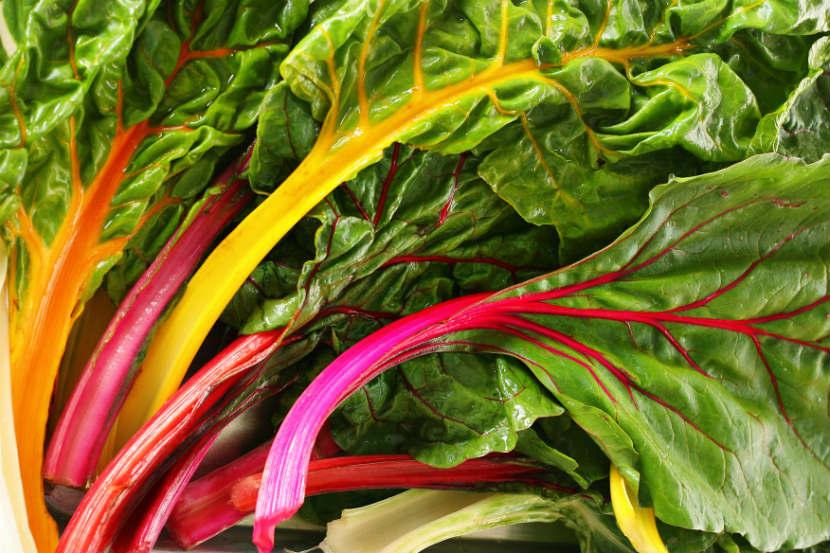 Keep mealtimes interesting by trying a new leafy green vegetable. Did you know that Swiss chard can be eaten raw or cooked? Here are some great ideas to get started with Swiss chard.
Keep mealtimes interesting by trying a new leafy green vegetable. Did you know that Swiss chard can be eaten raw or cooked? Here are some great ideas to get started with Swiss chard.
What makes Swiss chard healthy?
- Swiss chard contains vitamin K which helps your body heal wounds and keeps your bones healthy too.
- It also contains vitamin A to keep our eyes, skin and immune system healthy.
- Swiss chard is also a good source of magnesium which helps keep your muscles, bones and nerves healthy.
- Like other leafy greens, swiss chard is high in fibre and antioxidants and low in calories, fat and sodium (salt).
Buying local Swiss chard
Look for Swiss Chard at your local Farmers’ Market or grocery store. When you buy local food, you support farmers so they can keep producing high quality, affordable food we can all enjoy.
You are watching: All About Swiss Chard
Buy it best
- Swiss chard has large green crinkly leaves with celery-like stalks. Choose Swiss chard with crisp leaves and firm stalks.
- Look for different varieties of Swiss chard to experiment with different flavours and textures.
Tips for storing Swiss chard
- Raw Swiss chard should be kept in a plastic bag in the fridge for up to 3 days. Rinse well in water just before using.
- Cooked Swiss chard will keep in an air tight container for up to 5 days in the fridge. You can also freeze it for up to 12 months.
Tips for cooking Swiss chard
Before cooking Swiss chard:
- Rinse well with water
- Cut about ½ inch off the bottom of the stems
- Trim any leaves with brown spots
Keep in mind:
- Swiss chard leaves can be eaten raw or cooked
- Raw Swiss chard is less bitter than cooked
- A bunch of raw Swiss chard will cook to a much smaller amount
- The stalks are thicker than the leaves so they take longer to cook. Chop the stalks into 1 inch pieces. Sauté, steam or cook the stalks in a pan with water (1/2 cup per bunch) first, then add the leaves and cook until wilted.
5 things to do with Swiss chard
- Add chopped fresh Swiss chard to other salad greens.
- Toss in a handful of chopped Swiss chard to your next stir fry, soup or omelet like in this Swiss chard and navy bean soup or this colourful Eat Your Greens Frittata.
- Sauté Swiss chard in a little olive oil and garlic. Add a sprinkle of lemon juice and pepper before serving.
- Sauté Swiss chard in a little chili oil. Top with toasted sesame seeds.
- Use the leaves like a tortilla wrap. Here are a few filling ideas:
- spicy lean ground beef with diced onions and peppers
- lemon-garlic shrimp with any vegetables on hand
- grated carrots/beets and hummus
How can a dietitian help?
Read more : Do Garden Gnome Statues Symbolize Good Luck?
Dietitians can support you throughout many phases of your life from pregnancy to eating well when you are older. Counselling sessions with a dietitian can also help you to prevent and treat health conditions like diabetes and heart disease. Your dietitian will work with you to give you personalized advice that meets your lifestyle and goals. Connect with a dietitian today!
Bottom line
Swiss chard is a type of leafy green packed full of nutrients like fibre, vitamin K and magnesium. It can be eaten raw or cooked. Try adding Swiss chard to your next soup or salad!
You may also be interested in:
Read more : Vrinda Garden (Homestay), Varanasi (India) deals
All about dark leafy vegetablesEveryday tips for washing vegetables and fruitTop 5 reasons to see a dietitian This article was written and reviewed by dietitians from Dietitians of Canada.
Last Update – May 6, 2022
Source: https://gardencourte.com
Categories: Garden news

